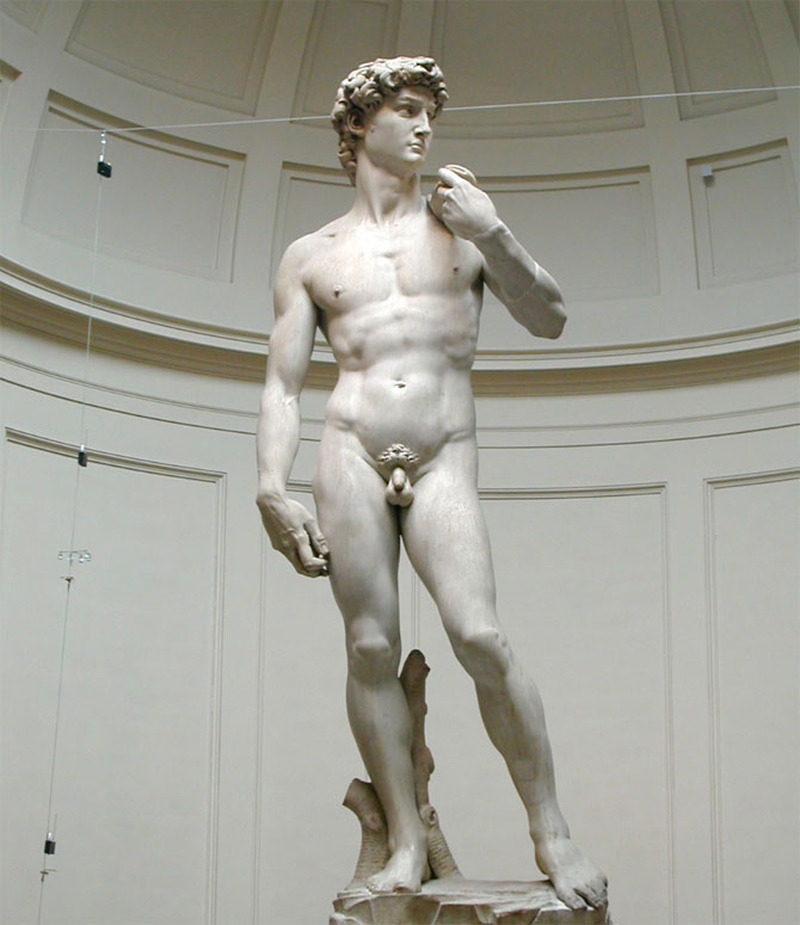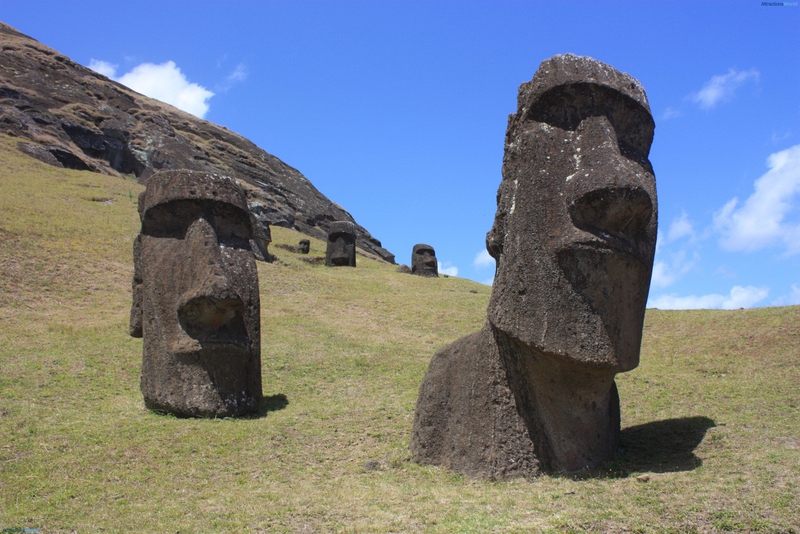For many centuries, famous artists have offered humanity with unbelievable things. Most importantly, sculpting art has taken a center stage. Man has continued to create famous sculptures since time in memorial. For various reasons, these sculptures have been created in different sizes. The initial Seven Wonders of World has two statues: The Colossus of Rhodes and The Statue of Zeus at Olympia. At present, statues have been created around the world and have continued to represent everything from various religious deities, influential individuals and historical events.
Top 10 Famous Sculptures
David
Time: 1501 - 1504
Sculptor: Michelangelo Buonarroti
Location: Florence, Italy
David was done by Michelangelo, an Italian artist. Located at Florence in Italy, David is a regeneration work of art that was shaped between 1501 and 1504. The sculpture is a 5.17 meters marble statue standing stark-naked and is considered a representation of the Biblical David, a highly esteemed subject in Florence art. Initially, the sculpture was commissioned among a series which was to be placed high up on the Florence Cathedral façade; while in fact, it was taken to the public square at the Palazzo Della Signoria. This was the civic government seat in Florence from where it was revealed on September 8, 1504.
Venus de Milo
Time: 100 - 130 B.C
Sculptor: Alezandros of Antioch
Location: The Louvre Museum, Paris, France
Based on the information found on the sculpture’s base, Venus de Milo was initially thought to have been shaped by Alexandros from Antioch. At first, it was erroneously credited to the chief sculptor Praxiteles. What has surprised many is the allegation that it was found inadvertently in a farmer’s field. Venus de Milo artifact was shaped long ago between 100 and 130 B.C. Currently Venus de Milo is displayed at the Louvre Museum, Paris. The sculpture, a marble structure standing 2.03 meters high, is believed to represent Aphrodite, a Greek beauty and love goddess. The original base and arms have been lost.
The Thinker
Time: 1901
Sculptor: Auguste Rodin
Location: Musee Rodin
The Thinker was first done in 1880 and cast in 1901. Initially, it was known as the Poet and was part of a directive by Musée des Arts Décoratifs, Paris to shape an epic portal to be used as the museum gateway. Named The Gates of Hell, all the statutes originated from The Divine Comedy of Dante. The Thinker, made from bronze, finally presented itself in a miniature on top of the Gates of Hell pondering the fate of those beneath him, which is different from Rodin's original idea of depicting Dante reflecting over his poem in front of the Gates. As desired by the sculptor, the artifact is nude since he wanted a daring figure in the customs of Michelangelo to be a representation of both poetry and intellect.
Pieta
Time: 1498 - 1499
Sculptor: Michelangelo Buonarroti
Location: St. Peter’s Basilica, Vatican City
Pieta is a marble structure shaped up by Michelangelo Buonarroti between 1498 and 1499. The sculpture is a representation of Jesus Christ in the arms of Mary, his mother. This is one of the remarkable sculptures that brought Michelangelo to light. During this time, Michelangelo was barely 20 years old when he was asked to come up with a sculpture of Virgin Mary with her son in hes arms. With nearly 2 years, Michelangelo managed to explored the utmost of his talent as well as the potential of the single slab of marble and thus brought one of the most famous sculptures to this world.
Moai
Time: 1250 AD - 1500 AD
Sculptor: Polynesian Colonizers
Location: Easter Island, Chile
The world famous sculptures Moai are believed to be a representation of deceased ancestors as well as the incarnation of powerful living of the previous chiefs. The tallest of them all is Paro which is 10 meters high with a weight of 75,000kg. The heaviest of all weighs 86,000kg. By the time the Europeans visited the land, they were still standing but some have been cast down as clans clashed. After some re-erection and restoration, there are about 50 moai on Easter Isalnd and museums elsewhere.
Christ the Redeemer
Time: 1922
Sculptor: Paul Landowski, Heitor da Silva Costa
Location: Rio de Janeiro, Brazil
Situated on top of the 700 meters high Corcovado Mountain, the sculpture offers a sweeping panorama from the Guanabara Bay interior towards the North and to Lagoa Rodrigo de Freitas facing south. Christ the Redeemer stands out 39.6 meters high on a 9.5 meters base and 30 metres wide and it compares to the Cristo de la Concordia statue in Bolivia in terms of height. Primarily, it is a Christianity symbol that has been a renowned statue and an important portrait for Rio and Brazil at large.
Statue of Liberty
Time: 1875 - 1884
Sculptor: Frédéric Auguste Bartholdi
Location: New York
The sculpture is found in New York though it was initially made in France. Essentially, it is a gift for the French people to celebrate the centenary of the United States Declaration of Independence signing. Standing on Liberty Island, it is among the most famous sculptures and symbols in the world. The statue shows a woman in a stola, wearing sandals and a shiny crown. The woman is trampling a loose chain and has a torch in her right hand raised high. She is also holding a tabula ansata tablet. For centuries, the Statue of Liberty was the first thing in sight for millions of immigrants who came to the United States.
Great Sphinx
Time: 2500 BC
Sculptor: Pharaoh Khafre
Location: Giza, Egypt
The creator of the great Sphinx statue is not known clearly. However, there are unsubstantiated reports that it was constructed in about 2500 BC by the pharaoh Khafre, who was believed to have built the second pyramid located at Giza. Again, when it was shaped is still under discussion because other reports indicate 3001 BC and the face model which it represents is also not known. Located at the Giza plateau in Cairo, Egypt, the great sphinx is among the oldest and largest world statues. Though considerably small in size compared to the surrounding pyramids, The Great Sphinx is the world’s biggest monolith statue.
Terracotta Army
Time: About 246 BCE
Sculptor: Chinese government laborers and local craftsmen
Location: Lintong District, Xi’an, Shaanxi Province, China
Discovered by local farmers in 1974, the Terracotta Army is believed to have been constructed by about 700,000 workers dating back to the end of the 3rd century BCE (about 246 BCE). The Terracotta Army, also known as the Terracotta Warriors and Horses, is a terracotta statues collection representing the armies of China’s 1st emperor—Qin Shi Huang. The statues are of different heights representative of their roles in the army. The statues include chariots, warriors and horses. It is a form of funerary art of ancient China in which the king wished to continue his reign in his afterlife.
Manneken Pis
Time: 1618 - 1619
Sculptor: Hiëronymus Duquesnoy
Location: Rue du Chêne/Eikstraat and Rue de l'Étuve/Stoofstraat Junction, Brussels
The Little man pee, commonly known as Manneken Pis, shows a nude little boy urinating inside a fountain's bowl. People can easily reach its location through the left lane towards the town hall in Brussels from the renowned Grand Place. Over the years, it has been a symbol that depicts Brussel's rebellious spirit. Initially, it was a fountain that contributed to an important role in the previous delivery of drinking water from the 15th century. The importance of Manneken Pis grew more in the 17th century.
- 1.












View All Comments /Add Comment